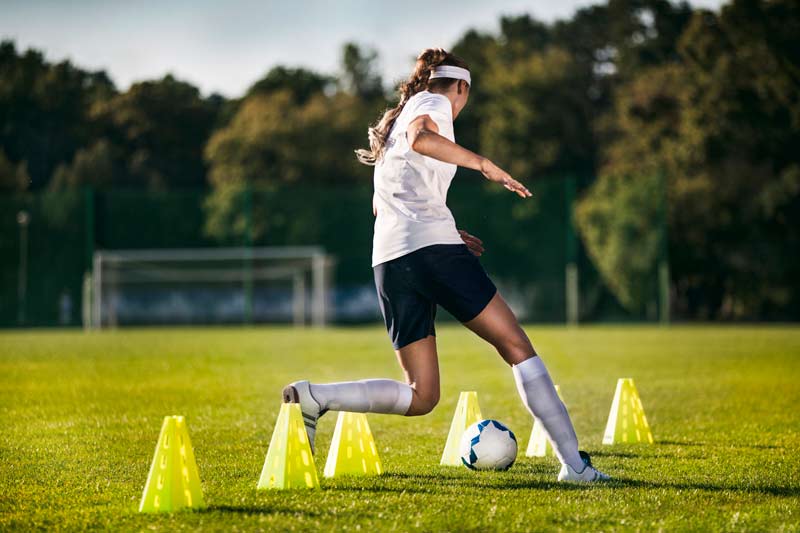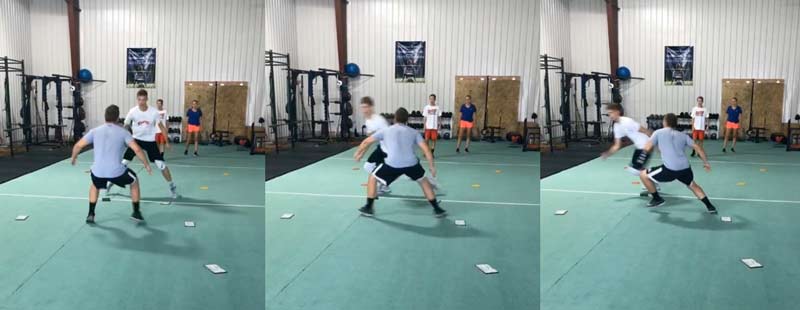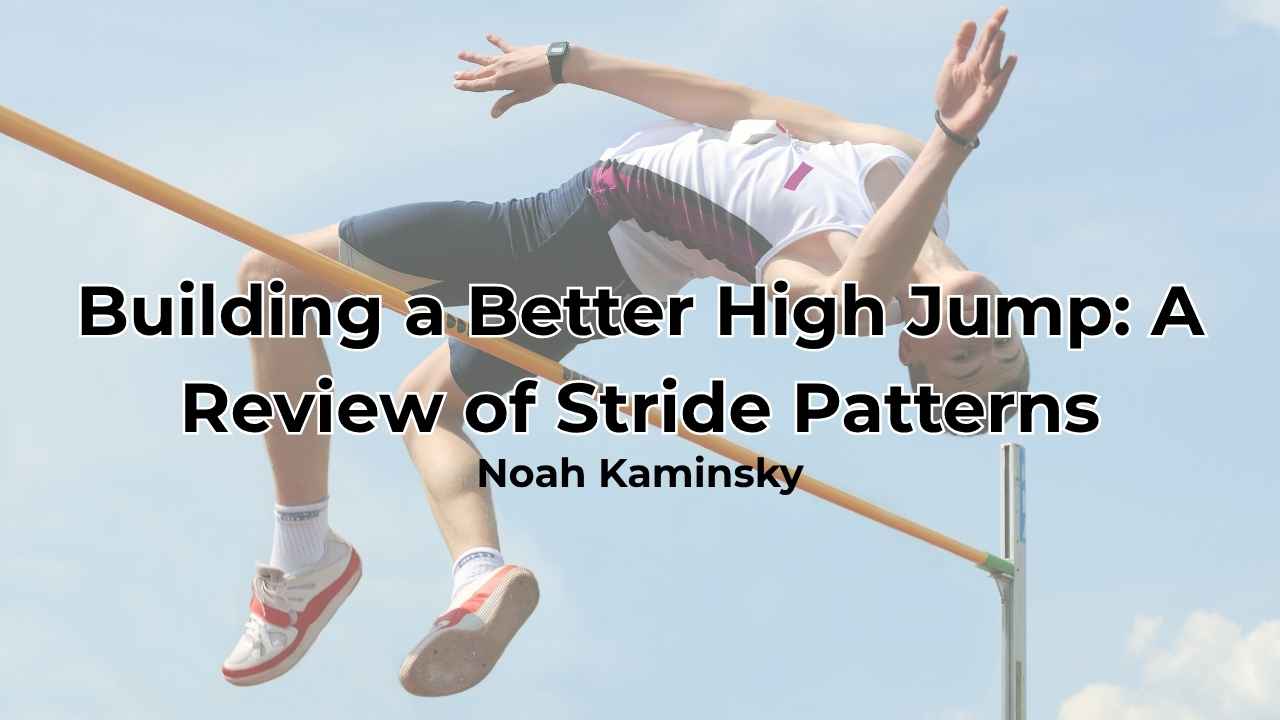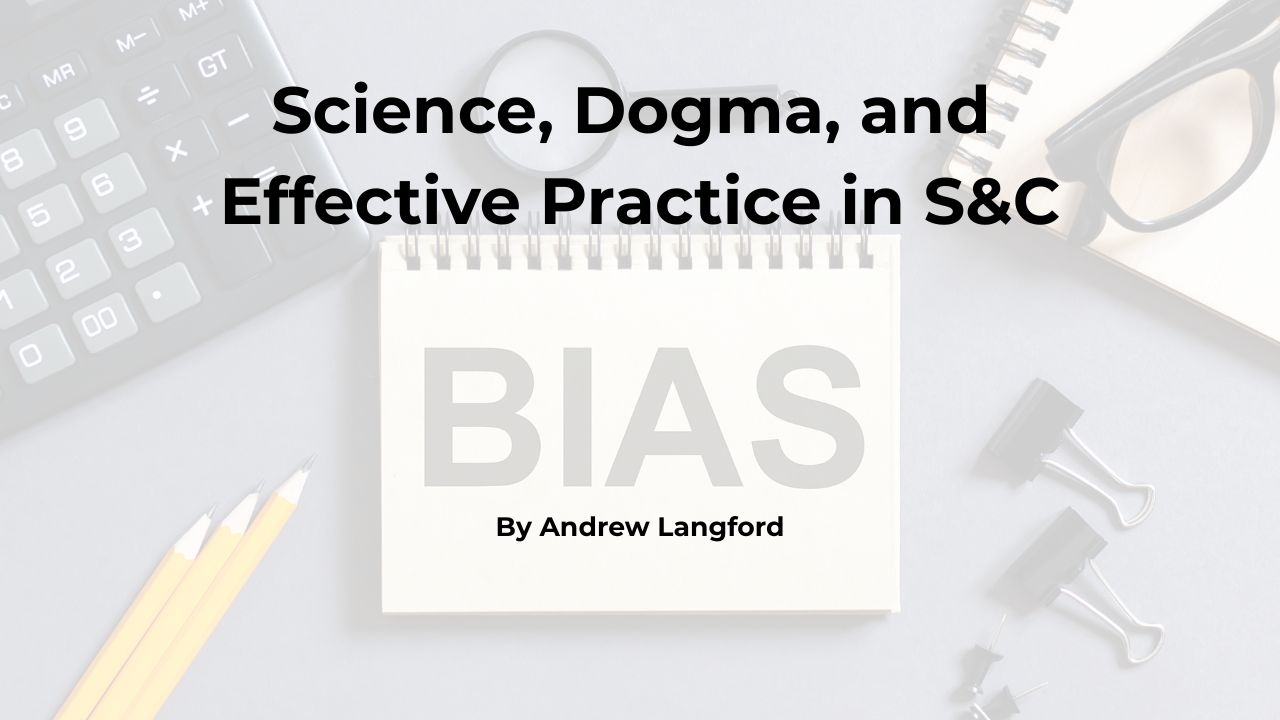[mashshare]

Agility might be the most misunderstood concept in the performance world as our profession lacks a thorough understanding of its meaning and its application. To be fair, agility has been misunderstood and wrongly defined for a long time. Even today, there isn’t a clear-cut definition for coaches. In this article, I describe common mistakes made when training agility and offer ways to transition toward training actual, true agility.
Over the past 40-years, agility has run through musical chairs of definitions. Since the 70s, we’ve used phrases such as:
- Ability to change direction rapidly
- Ability to change direction rapidly and accurately
- A whole-body change of direction and speed
The most accepted definition today is: “A rapid, whole-body change of direction and speed in response to a stimulus.”
The concept of agility gets a face-lift every decade, shifting toward a better definition for coaches and practitioners. These bouncing definitions, however, make it difficult for coaches to grasp the concept fully. Compound that with our biases and the lens through which we see our work, and we have a recipe for misunderstanding.
- Strength and conditioning specialists will typically look at agility through the lens of physical abilities–strength qualities, eccentric abilities, and reactive strength.
- Biomechanists will view agility from a mechanical and technical model of joint angles, change of direction (COD), body positioning, and foot placement.
- Someone with a background in motor learning and skill acquisition will view agility for its perceptual-cognitive aspects and emphasize decision-making and perception and action coupling.
Due to years of tradition and poor understanding, we still do research and athlete evaluation using the pro agility and Illinois agility tests–neither of which are actual agility tests and both continue to mislead coaches.
To put a stamp on our field’s misconception of agility, look no further than the term reactive agility. The phrase demonstrates a clear lack of understanding of the current definition which involves a response to a stimulus. Reactive agility is redundant, and continuing to use this term will hold our profession back from understanding the concept of agility.
Agility and Change of Direction Are Different
The biggest mistake made is the continued misuse of the terms agility and change of direction. They’re often used interchangeably, but they are not the same. The belief that they’re interchangeable has resulted in a disservice to our athletes and how we evaluate them for a long time.
COD involves changing direction or speed without a stimulus. It is closed and pre-programmed. Agility, on the other hand, involves a stimulus; it is open, random, and chaotic.
#Agility involves a stimulus and is open, random, chaotic. Changes in direction & speed do not, says @BBAPerformance. Share on XIt’s surprising that many still don’t distinguish between the two because, for quite some time now, literature has shown these are different skills. Not only that but agility performance, not COD performance, separates the higher performing athletes from the lower performers and is superior for identifying talent.
For a nice analogy, consider successful quarterback play in football. Three of the best quarterbacks of the last decade are Tom Brady, Aaron Rodgers, and Payton Manning. What do all of these guys lack? They’re far from the most physically gifted athletes in their position.
What separates them is their vision, play recognition, perception-action coupling, reaction to ever-changing play, anticipation, creativity, cognition, ability to pull from past experiences, etc. Every single play offers a different, distinct, and unique problem. And these guys are best able to find optimal solutions to these problems.

There have been quarterbacks who were bigger, stronger, faster, with better arms, with more accurate arms but who were lacking in the most important areas. They couldn’t solve the vast variety of problems football presents and, thus, were not successful despite having many physical tools.
Agility is the same. As strength and conditioning coaches, we tend to think about physical and COD abilities only and ignore these other areas. It’s these other areas, however, that separate the best from the rest.
The best movers and players at any position, in any sport, are rarely, if ever, the strongest or fastest or best at COD tests. Instead, they have the most adept perceptual-cognitive skills.
Too Much Technique
Far too much time is spent on the kinematics of COD and teaching athletes the “techniques” of agility. First, what is good technique? Here’s the dirty secret of COD and agility–there’s no such thing as good technique. There is no universal position, step pattern, or body position that makes agility perfect.
Herein lies the problem with technical and COD drills–the idea that a specific technique exists. Coaches need to be cautious when applying a specific technique to the complexity of agility within sport. Look at force plate analysis, and you’ll see large variations in how athletes approach a cut or COD, demonstrating that even in closed drills, there is no perfect approach or technique, and technique varies from rep to rep.
Think about working technique for a 90-degree cut. You can break it down, you can stress a square foot angle, lower COD, set a specific shin angle, and think you’re doing a great job. But in sport, how often does a perfect 90-degree cut occur? How often does it occur in that perfect, safe training setting where the athlete knows exactly where to plant, with what foot, and in which direction?
It’s no wonder coaches complain about training technique for hours and then watch as technique disappears when athletes play in an open, chaotic, competitive environment. The athletes break down when exposed to an unexpected and chaotic environment.
Hammering away at COD drills keeps athletes comfortable, is predictable, and develops movement automation rather than continually stimulating perceptual-cognitive actions. Instead, we want to present athletes with movement problems and allow them to experiment to find solutions creatively.
COD drills make our athletes robotic, rehearsed, and uncreative–not creative, robust, reactive, says @BBAPerformance. Share on XIf we only do closed COD drills, we fail to challenge athletes in these areas. Instead of developing creative, robust, reactive athletes, COD drills make our athletes robotic, rehearsed, and uncreative.
Dr. Sophia Nimphius, a leading COD and agility researcher, has said that agility is about producing a motor response despite the position in which athletes find themselves. Agility within sport is rarely clean and pretty, but athletes still have to move. They need doses of venom to prepare for the realities of sport.
Now, there is certainly a time and place for technical and COD drills to help establish context and feel for athletes. But to spend the majority of your movement training working technique in closed COD drills is time poorly spent.
The Motor Response Depends Upon the Stimulus
Motor response and subsequent kinematics are dependent upon the athletes’ perception and response to a stimulus. This major concept is underappreciated when it comes to technique. The end motor response and displayed technique depend on when, where, what, and how an athlete responds to a particular stimulus. If coaches don’t appreciate this, no COD will ever stick or transfer.
There’s a common mindset that we should duplicate a certain pattern or position of an athlete in sport. While the intentions are good, it’s important to understand the specific context of the movements. If you try to perform these movements outside that specific context, a disconnect will occur, and there will be a lack of transfer.

As coaches, we have to respect how the athlete perceives a specific stimulus within environmental and task constraints, game setting, and their past experiences. These dictate the technique an athlete chooses in that instant. Every athlete is different in this sense, and we need to be a guide and a passenger in this process. Because we can’t see or feel what the athlete does during an agility movement, our job is to pull out relevant information and guide the athlete to think about what they perceived and what that means.
Using COD drills is analogous to skipping to the end of a book–the ending won’t make any sense because we missed what led to that ending. Everything leading up to the ending builds and develops the context which connects everything. And everything before a movement builds and develops into the subsequent motor response.
So while good in nature, most time spent on COD drills is wasted because there’s no connection between a stimulus and movement in sport.
Specific Stimuli for Sport
To make agility stick and transfer to sport, coaches must ensure the training stimulus is specific to the sport.
- The number one stimulus for team sport athletes is another athlete–the opponent.
- Next, depending on the sport, implements like bats, balls, and rackets are also major stimuli.
- Finally, the environment (game setting, situation, on-field location, score, game time, and the location of all players) will also play major stimuli role.
Not relevant to any of these stimuli are flashing lights, pointing fingers, colored cones, etc. It’s become a hot trend to use these stimuli to improve agility–they don’t. Research suggests a flashing light stimulus, specifically, is not useful and does not cause a transfer to actual sport performance. The intent of these tools makes sense, but the application is wrong.
Higher performing athletes are better able to shift, extract, and identify specific stimuli from their sport and then apply a fast and accurate motor response. Coaches need to remember this. I don’t remember watching a game where the athletes were reacting to flashing lights. Until that happens, these tools are a waste of money.
Athletes need exposure to identifying, deciphering, and sifting through the cues of an opposing player, environment, and situation to make the most optimal motor response. Research indicates this perceptual-cognitive ability is trainable. And with training, athletes can improve their ability to extract and interpret sport-specific information for faster and more accurate motor responses.
Respecting Speed
Again, the most accepted definition of agility currently is: “A rapid, whole-body change of direction and speed in response to a stimulus.”
People often miss the part about the change of speed in this definition. Some of the best movers, however, can manipulate, adjust, and control their speed better than their peers.
Also, many COD drills and tests like the pro agility and the L-Drill don’t respect the need to control speed. Watch these drills, and you’ll see athletes flailing, uncontrolled through the finish. When is exhibiting total lack of control beneficial in sport?

Athletes need the ability to make abrupt changes in speed and to control that speed. Being able to decelerate on a dime, under control, is vital for sporting success. If, for example, you’re defending a player who drives left on you, committing too much speed or moving uncontrollably to the left would be a poor response–the opponent would cut back and beat you.
Great agility does not mean you’re always the fastest to react but that you’re able to react to the right stimulus, at the right time, at the right speed. Remember, the best solution is not always the first or fastest response; it’s the appropriate response.
Duration of COD Tests
A big issue with much of the research on COD tests is that many of the studies use tests that last for 10-20 seconds; the test becomes a measure of anaerobic capacity and linear sprinting speed rather than specific COD abilities.
This misunderstanding also sprinkles down into the structure of many of popular agility drills implemented by coaches. It seems coaches are trying to fit every imaginable movement into a single drill, and the drill ends up lasting 15-20 seconds. The drill quickly becomes a test of anaerobic capacity instead of focusing on COD and agility demands. As coaches, we need to respect the bioenergetics of sport and stop trying to fit ten different movements into a single drill. Think of agility like sprinting–keep it short and sweet.
Embracing the Ugly
It’s important to understand that agility aims to enhance transfer and effectiveness of on-field movement. Training will be ugly, and mistakes will occur which is the exact opposite of how typical COD drills and tests operate. With COD drills, the end goal is to improve the drill’s execution and lessen mistakes. They don’t help the athlete with the actual demands of sport where the athlete does not move in pre-programmed ways. Rather, they move in response to an ever-changing environment.
The beauty of agility training is that we give athletes opportunities to assess their movements, as well as their opponent’s movements, within the context of the environment and see how it impacts the outcome.
Actual #agility environments provide opportunities for mistakes and, thus, opportunities to learn, says @BBAPerformance. Share on XHow? An actual agility environment provides ample opportunities for mistakes. With each mistake comes a great learning opportunity.
In actual agility environments or small-sided games, the athlete continually receives information from opposing players, the environment, and the task. They constantly take this information and apply a motor response. They receive immediate feedback on whether their response was successful. And they store these outcomes away, building a library of results to later pull from when similar problems arise.
And this process is not singular, it repeats and repeats. Think about how rich this learning environment is. Embrace the ugliness of agility and small-sided games, and help your athletes explore by asking open-ended questions and for feedback of what they saw, felt, and thought.
How to Train Agility
- Continually change the context of agility drills. Challenge or change the environment or task as much as possible. You could have the athlete start in a different stance, have the opponent come from a different angle, at a different speed, from a different distance, and with different task objectives. The changes don’t have to be drastic, but continually adding little disruptions will keep learning high.
- Masterful agility is about being resourceful and able to solve the problem presented by the environment quickly. Using drills with multiple athletes working together or against one another is a great opportunity to expose athletes to hundreds of scenarios and movement problems. Quality agility drills don’t always have to be one versus one or mirror drills.
- Offense Defense. Agility should be context-specific as much as possible. Putting offensive players in offensive roles and vice versa for defensive players helps develop task-specific cue recognition. This is important because offensive players typically need to evade, avoid, and manipulate, while the defense needs to read, react, and defend.
- Direct the eyes. Train the eyes and brain to detect specific cues from opposing athletes and the environment. Research on eye-tracking analysis demonstrates that better players fixate longer on key body regions compared to lesser athletes. So hint at body locations, ask what they saw and perceived, and place external cues at desired locations. Flags and towels are great because they direct the eyes to the desired
- Add a cognitive component with a generic stimulus. When using colored cones, pointing fingers, or flashing lights, add a cognitive and mental processing component whenever possible. Ways to do this are:
- Start drills by using different stimuli–a whistle, clap, tennis ball dropping, coach’s movement, specific word, or “on 2.”
- Present a math problem to initiate a direction. When the equation equals an even number, the athlete runs left, and with an odd number, the athlete runs right.
- Add fakes, such as pointing left, yelling right; saying blue and pointing to red.
- Make athletes pick out relevant information. Have an athlete turn around, have another group of athletes huddle up and one of them grabs a ball. On the whistle, the athlete turns around while the others run around. The single athlete must look for the athlete with the ball and tag them.
All of these add a mental processing component just as, for example, a safety in football has a certain responsibility on a given play–though that responsibility depends on the offense’s alignment, motions, a certain player’s location, down and distance, etc. These challenge mental processing, albeit not in a specific manner, but better than other, more general modalities.
Since you’re here…
…we have a small favor to ask. More people are reading SimpliFaster than ever, and each week we bring you compelling content from coaches, sport scientists, and physiotherapists who are devoted to building better athletes. Please take a moment to share the articles on social media, engage the authors with questions and comments below, and link to articles when appropriate if you have a blog or participate on forums of related topics. — SF
[mashshare]




